
Wall of Dignity
In 1967, Detroit experienced one of the most brutal race rebellions in its history. In the early hours of June 23rd, the police raided an after hours club. Expecting to find a few people inside, they instead found 82 individuals. Everyone was arrested and escorted from the building, and as this happened, a crowd of 200 people gathered. As the night slowly crept into the next morning, violence and looting emerged on Twelfth Street, and the Detroit rebellion was underway. The rebellion carried on for five days. Mayor Jerome Cavanagh initially sought to quash the uprising with police units, but failed to gain support for this tactic as many African Americans in the city deemed the police the problem. In 1968, a year after Detroit’s violent rebellion, a local community organizer named Frank Ditto contacted muralists Bill Walker and Eugene Eda Wade, asking them to create a mural in his local community. Wanting to create a mural that could project an expression of black unity during a time of racial pain, Walker and Wade set about creating the Wall of Dignity. Painted on the façade of an abandoned ice-skating rink, the mural was broken down into three main sections. The top half of the mural depicted diasporic scenes of ancient life in Africa, whilst the middle section functioned as a collection of portraits of prominent African American men and women who sacrificed their lives by fighting for black liberation throughout history. The faces of Marcus Garvey, Malcolm X, Martin Luther King Jr., Mary McLeod Bethune and Stokely Carmichael line the wall. The bottom section of the mural, enveloping the words ‘The Wall of Dignity’, depicts scenes of enslavement. Silhouetted figures of manacled men and women stretching their chains taut as they stretch for freedom are countered by figures raising their unshackled hands to the sky in moment of liberty. Towards the left-hand side of the mural, a poem titled ‘Slave Ship’ reads:
I am a prince, speak with respect I shall not be chained to your Bloody deck To live in this filth and stench? Ooooaaee a poor soul have died on his bench This meaning does burst the drums of my ears Long hours from my home seem like years A prince to ear the food of jackals!! My arms, my leg bleed from your shackles You must look to my woman What had been done to one so sweet, so mild? AAAHHH! Within here was my child. Strange tongued-golden haired man I will not journey to your land. Leave me…leave me be… Cast my carcass into the sea The sea.. Black..Black like me.

Mobee Royal Family Orginal Slave Relics Museum
The Mobee Royal Family Original Slave Relics Museum is a small museum housed in a nineteenth century colonial building. It showcases the role of the local 'Chief Mobee' in the enslavement of local Africans during the transatlantic slave trade, as well as the role of his son (and successor) in abolishing slavery in the area.
The museum houses one exhibition which discusses the arrival of Europeans to the Badagry area and the origins of the trade in human beings. Artefacts highlight the brutal nature of the capture and the enslavement of African people. These include yokes, chains, a mouth lock that presented the captives from speaking, and handcuffs for children. Other objects are examples of trade goods that were received by the Chief in exchange for a supply of people. Text interpretation also provides visitors with information about the terrible conditions faced by the enslaved during the Middle Passage, and images provide representations of life on the plantations.
The museum is often visited as part of a 'Black History Tour' with the former slave market and the Black History Museum.

Old Residency Museum
The Old Residency Museum is housed in a colonial building, designed in Scotland and shipped to Nigeria during the 1880s. It previously housed the British colonial administration in Nigeria. The museum holds the largest collection of Nigerian documents and artefacts in the world. It focusses on the history of the Calabar and Cross River Regions, as well as slavery, and is managed by the National Commission for Museums.
The first exhibition encountered by visitors on their entry to the museum explores the four centuries of the trade in people that permeated Nigeria and the region. There is a significant display of European items that were used as trade goods in exchange for enslaved Africans. This includes Venetian glass beads, pewter pots, ceramic pots, shaving sets and guns. Other displays include items that illustrate the brutal nature of enslavement, including chains and manacles.
The museum's other exhibition examines the production processes of palm oil, as one of the most important exports to Calabar, after the abolition of the slave trade.
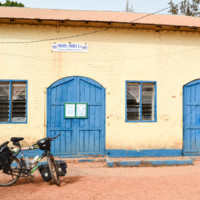
Museum of Slavery
The Museum of Slavery in the village of Albreda first opened in 1996. It is housed in the Maurel Fréres building which was built by the British colonial government in the 1840s. Only a short distance from Juffure, the home of Kunta Kinte - the main character of Alex Haley's 'Roots' - the museum is dedicated to interpreting the history of transatlantic slavery in the area. It is a hub for students and researchers.
The museum's displays use a collection of artefacts to examine the process of enslavement, with particular focus on capture and the Middle Passage. These artefacts include chain neck collars, foot cuffs, yokes and manillas. The museum also has a display about 'Roots'.
Guided tours are regularly welcomed to the museum. Visitors are also frequently taken to visit the nearby 'factory' ruins which was once used as a slave station by French and British colonial administrations.
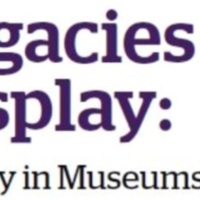
The National Great Blacks in Wax Museum
The National Great Blacks in Wax Museum opened in 1983. It was set up by Drs. Elmer and Joanne Martin as a cultural and educational institution that focusses solely on the study and preservation of African American history. It is a unique organisation as it represents the histories it interprets through the use of life size wax figures, presented in historical settings. The museum has several objectives, including to increase interest in African American history, to use inspiring examples from history to motivate young people to achieve, and to improve race relations by dispelling myths of racial inequalities. The museum attracts around 300,000 visitors annually.
The museum features thirty-five installations of 'great blacks' in a range of scenarios. These cover a large temporal and geographic span, beginning with representations of key figures in pre-slavery Africa, through to dioramas of the space race and modern science. The key focus is on black achievement through all sectors of society, including politics, the military, sport and business.
Many of these installations link to the history of slavery in the United States. They examine the Middle Passage and captivity, plantation life and resistance with graphic displays of the instruments of brutality utilised in the system of enslavement. Others depict key characters in African American journeys to freedom including Henry 'Box' Brown and W.E.B. Dubois. The abolition movement is incorporated into the installations with the characters of Frederick Douglass and Sojourner Truth. The Underground Railroad is also depicted in a display with Harriet Tubman, amongst others. Many of these dioramas also incorporate models of children.
The displays continue to chart the twentieth century, examining the Civil Rights Movement, Black Power, and the Jim Crow Laws. Some of these dioramas illustrate the abhorrent nature of the racial violence that dominated the United States, such as lynching, in graphic detail.
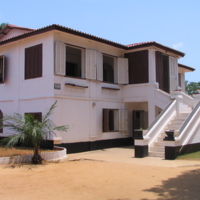
Le musée d'histoire de Ouidah
Le musée d'histoire de Ouidah (The Ouidah Museum of History) is located within the Old Portuguese Fort in Ouidah. The Fort was used to contain and transport enslaved Africans as part of the transatlantic slave trade, serving as the site for diplomatic presence of Portugal in the area. The fort became property of the Dahomean government in 1961, when it was restored and turned into a museum, opening in 1967. It is managed by the Department of Cultural Patrimony.
The museum's collections are grouped into six major exhibit themes: the Portuguese Fort (in which the museum resides), the Kingdom of Xwéda, the Kingdom of Dahomey, the Slave Trade, Vodun, and the cultural links between Benin and the New World. These collections are made up of artefacts, photographs and objects that have significant meaning to the history and culture of the museum's local area.
The history of slavery runs throughout the displays; from the Portuguese Fort display which discusses how enslaved Africans were kept there. The displays that explore the kingdoms of Xwéda and Dahomey use collections to emphasise the extent to which both of them were dependent on the trade in enslaved individuals with Europeans for riches and power. These include a range of archaeological finds, as well as engravings and drawings. The exhibition about the religious traditions of the area, in particular the development of Voodoo, reflects on the continued use of African religions by enslaved people in the Americas during the period of the transatlantic slave trade, using religious artefacts. A range of images and objects showcase the impact that people from Benin made on the cultures of New World societies, as well as the effects of mass repatriation to Benin after the decline of the slave trade.
The Slave Trade exhibits examine the system of transatlantic slavery from the sixteenth to the nineteenth century and how it impacted on the local area. The main focus is on the economic and social processes that the slave trade created in Benin, capture, enslavement and the Middle Passage. These themes are illustrated with a range of objects, artists' renditions and archival materials. Examples of objects on display include chains and yokes. Images are also used to give some information about the plantation system in the Americas and Caribbean.
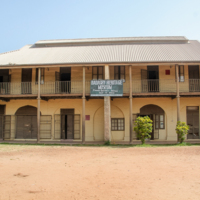
Badagry Heritage Museum
The Badagry Heritage Museum is housed in the former district officer’s office that was constructed in 1863. The museum attempts to highlight the injustice and horror of the transatlantic slave trade, whilst also exhibiting the rich histories and cultures of Africa. There is a specific focus on the heritage of pre and post-transatlantic slave trade in Badagry. The museum consists of eight galleries each dealing with particular themes relating to local heritage and the transatlantic slave trade. Guided tours are available. The museum is managed by the Nigerian Cultural Commission.Each of eight galleries are named after a part of the transatlantic slave trade. The first, the 'Introductory Gallery', focuses on the founding and early history of Badagry. The next five galleries all deal specifically with distinct phases of the slave trade, from capture, transportation, material culture, resistance, and industry. In these galleries are objects that illustrate the brutal nature of enslavement, including shackles and manacles, as well as replicas of slave ships. The seventh gallery examines the forced integration of the enslaved into the countries they were transported to, featuring videos of reconstructed slave auctions. Finally, the last gallery explores abolition movements and the persistence of slavery even after its legal end. The museum has attempted to incoporate the voices of local people within the displays, as well as depicting the significance they place on certain cultural and historical items within the museum. In addition to the historical collections, there are also some examples of contemporary art throughout, showing modern reflections on the systems of enslavement.
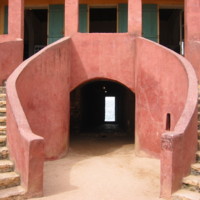
House of Slaves
The museum is located on Gorée Island, 3 km off the coast of Senegal. The structure was built in 1776 as a holding centre for Africans waiting to be exported across the Atlantic. It was converted into a museum and memorial in 1962. According to the original curator of the museum, Boubacar Joseph Ndiaye, the island played a pivotal role in the containment and transportation of slaves to America during the transatlantic slave trade. The aim of the museum and memorial is to help its visitors come to terms with the extent of the transatlantic slave trade and the effects of the trade on Africa and its people. It was designated a UNESCO world heritage site in 1978.
The content of the museum includes murals and artwork showcasing traditional African techniques, and depicting the process of enslavement. There is also a variety of objects such as chains, manacles, and cages which emphasise the brutal nature of slavery. The site itself is accessed via a ferry and the tourism industry of nearby Dakar is linked closely with the island. The key voices addressed within the museum are those of the enslaved; the museum brings visitors into close approximation with the living conditions faced by the enslaved during the transatlantic slave trade. One of the most poignant features is the 'Door of No Return' which is said to be the point where enslaved Africans were boarded onto ships ahead of the Atlantic voyage.
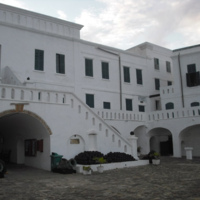
Cape Coast Castle
Cape Coast Castle is one of around forty ‘slave castles’ built by European traders on the coast of West Africa and used to hold enslaved Africans prior to their being transported to the Americas or the Caribbean. The first timber construction on the site was erected in 1653 for the Swedish Africa Company named Carolusborg. It was later rebuilt in stone. In April 1663 the ‘Swedish Gold Coast’ was seized by the Danes and integrated into the ‘Danish Gold Coast’. In 1664 it was conquered by the British. Originally used for trade in timber and gold, the castle was later used in the transatlantic slave trade. In the late 18th century it was rebuilt and used as the seat of the colonial Government of the British Gold Coast in 1844. In 1957, when Ghana became independent, the site came under the care of the Ghana Museums and Monuments Board, and was restored for public access in the 1990s. The museum offers guided tours, as well as permitting tours orchestrated by freelance tour guides. There is also a library and a gift shop, featuring traditional Ghanaian arts and crafts, on site.
The main aim of the museum is to act as a monument to those taken from Africa and enslaved into the system of Transatlantic Slavery. It features both archaeological and ethnographic collections on displays, within the rooms of the castle. Throughout, there are also a number of contemporary sculptures depicting the heads of victims of the slave trade. Visitors tour through the castle, encountering the rooms in which the enslaved were held, with guides providing further information about the conditions and experiences those thousands of Africans faced.
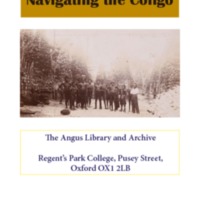
Navigating the Congo
Featuring artefacts, navigational equipment, maps, photographs, personal letters and diaries, Navigating the Congo is an exhibition which explored the history of non-conformist involvement in the Congo River regions during the 19th and 20th century.
By looking at the collections held in The Angus Library and Archive, the exhibition sought to bring to light some of the challenges faced in navigating this history and the relationships that developed between Baptist missionaries and the Kongo people during the period of European colonialism.
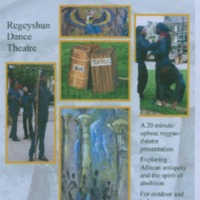
Sugar Beat Skank
Sugar Beat Skank was a reggae-theatre performance presented by Regeyshun Dance and commissioned by the Leeds Bicentenary Transformation Project. It explored 'African antiquity and the spirit of abolition', and gave voice to narratives linking the histories and cultures of Africa and Yorkshire. Sugar Beat Skank was performed at outdoor and indoor events across Yorkshire, including Ilkley Literature Festival in 2007.
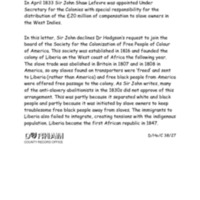
Exhibition to mark the bicentenary of the 1807 Act
Durham Record Office held an exhibition of its original documents relating to slavery, the slave trade and abolition. These include reports, maps, and a number of letters, from, for example, Sir John Shaw Lefevre (Under Secretary for the Colonies in 1833), the abolitionist James Stephen and the prominent Quaker activist Josiah Forster. The exhibition was displayed in the Record Office and toured several venues in the region. It was also used for inspiration by members of Jackass Youth Theatre, who produced the play Sharp Practice after visiting the Record Office and consulting some of the original documents on display.
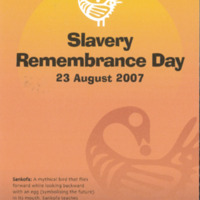
Slavery Remembrance Day in Liverpool
Slavery Remembrance Day, as designated by UNESCO, took place in Liverpool on 23 August 2007. The day was commemorated with a series of events, marked first by a multi-faith act of worship at Liverpool's Parish Church of St Nicholas. A traditional African libation ceremony, calling on ancestors to bless the event, took place on the city's waterfront at Otterspool Promenade. A programme of music and drama showcased Black culture and heritage around the themes of life in Africa, the Middle Passage and the legacies of transatlantic slavery. The International Slavery Museum at the Albert Dock had its official opening on the same day. The symbol of the day was the Sankofa, a mythical African bird that files forward while looking backward.
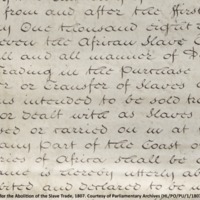
Voices from Africa
To commemorate the bicentenary, St Mungo Museum of Religious Art and Life (with support from the Scottish Museum Council) explored the social and economic legacies of slavery, including racism and cultural stereotyping. The museum worked with members of Glasgow's African and African Caribbean communities on reinterpreting objects from across Glasgow Museums. As part of the project, artist Beth Forde was commissioned to create an artwork to explore some of the issues raised, titled 'The shadow of the object fell upon the ego'. Voices from Africa was part of a year-long programme of lectures, schools events and exhibitions highlighting the life of African communities in Glasgow. This included a photographic project with photographer Roddy Mackay to represent African heritage in Scotland, and a series of free workshops exploring aspects of faith and belief.
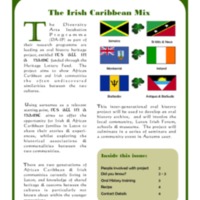
It's All in a Name
It's All in a Name was an oral history project led by the Diversity Arts Incubation Programme in Luton. A collaboration between the local community, Luton Irish Forum and local schools and museums, the project aimed to discover the historical associations, shared customs and heritage between African Caribbean and Irish communities in Luton, using surnames as a starting point (popular surnames shared by both communities include Murray, Nugent or Patrick). The project developed an oral history archive, and culminated in a series of seminars and a community event.
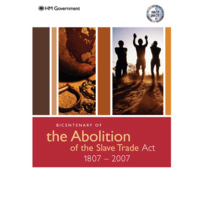
Bicentenary of the Abolition of the Slave Trade Act 1807-2007
The official publication from the British Government in response to the bicentenary included a message from Prime Minister Tony Blair. It set out the history of transatlantic slavery and resistance to it, and featured a calendar of upcoming events for 2007 relating to slavery and abolition. The publication also detailed contemporary efforts to end modern slavery. Later in 2007, 'The way forward: bicentenary of the abolition of the Slave Trade Act 1807-2007' reflected on some of the commemorative activity that had taken place in Bristol, Hull, Liverpool, London and Greater Manchester. With a foreword by the new Prime Minister, Gordon Brown, the theme of the publication was 'Reflecting on the past, looking to the future' and it linked efforts for the abolition of historical and contemporary slavery. The publication also looked to how to tackle inequality and poverty in the UK, Africa and the Caribbean.
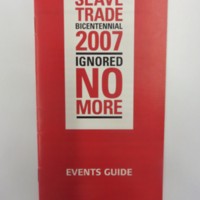
Abolition of the Slave Trade Bicentennial 2007: Ignored No More
The Greater London Authority produced an Events Guide for Londoners in 2007 detailing some of the initiatives taking place in the capital involving the Mayor. This included Africa Day on Trafalgar Square, celebrating the positive contributions of London's African communities, and 'Rise: London United', an anti-racist music festival. The conference 'Faith Symposium: In God's Name?' at City Hall examined the role of the Church in the transatlantic slave trade. There was also a seminar on the legacies of the transatlantic slave trade from a Caribbean perspective and a Caribbean Publishers Book Fair held at London Metropolitan University. The Dr Eric E. Williams Memorial Lecture Series at City Hall was made available as a webcast.
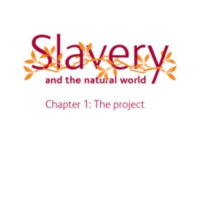
Slavery and the Natural World
In consultation with local community groups, in 2007 the Natural History Museum commissioned new research into its collections that link slavery and the natural world. The research uncovered experiences of enslaved people and the use of plants in their everyday life, as food, medicines and poisons. It also examined the complex relationships between enslaved people and naturalists exploring newly-colonised lands. The museum ran a series of public events, co-hosted by Race on the Agenda, which aimed to bring the historical, scientific and public viewpoints together. It created online educational resources on themes such as Commercial Plants, Everyday Life, Diet and Nutrition, and Resistance. The museum also developed cross-curricular ideas for school lessons in Science using the context of slavery, looking at foods across different cultures, for example.
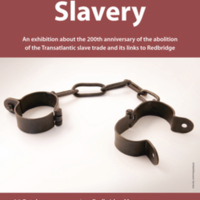
Redbridge and Slavery
Redbridge Museum's exhibition to mark the bicentenary examined the London Borough of Redbridge's connections to the slave trade and abolition. These links included local resident Josiah Child, once Governor of the East India Company, an investor in the Royal African Company and owner of plantations in Jamaica. The Mellish family of Woodford had connections with the West India Docks in London, built for the sugar trade. Alexander Stewart of Woodford owned Jamaican plantations and acted on behalf of owners of enslaved Africans in compensation claims after abolition. The exhibition also examined church records detailing some of the Black residents of Redbridge in the 17th and 18th centuries. Music from the Caribbean island of Dominica was included, as was a series of personal responses to the bicentenary by local residents.
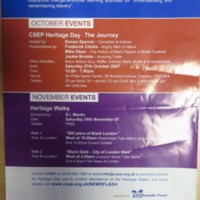
Newsflash: Heritage Chronicles
The Croydon Supplementary Education Project (CSEP) offers community-based learning initiatives to Black and Ethnic Minority communities in Croydon. Newsflash: Heritage Chronicles was a range of free interactive intergenerational learning activities for understanding and remembering slavery. The programme included heritage days, heritage walks with historian S. I. Martin, and information and research to dispel myths about Africa before the arrival of the Europeans, such as the featured sheet about the Ghana, Mali and Songhai Empires.